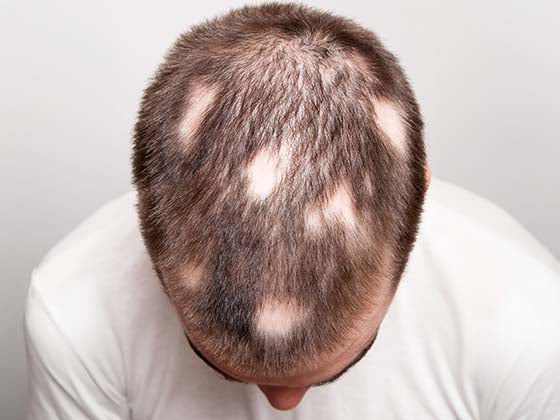Red patches on the scalp can be worrisome and painful, typically indicating an underlying scalp problem that requires treatment. Depending on the reason, these patches can cause itching, peeling, swelling, and even hair loss. Understanding what is causing the red patches and how to manage them might help relieve pain and prevent future problems. In this blog, we will learn about red patches on the scalp.
Common Causes of Red Patches on the Scalp

Red patches on the scalp can be produced by a range of factors, ranging from minor discomfort to major illnesses. The most common causes include seborrheic dermatitis, psoriasis, allergic responses or sensitivities, folliculitis, ringworm (tinea capitis), lichen planus, dermatitis herpetiformis, and sunburn.
Scalp Psoriasis: Symptoms & Management

Scalp psoriasis develops when the immune system overproduces skin cells on the scalp, causing a buildup of thick, silvery scales. It is a kind of psoriasis, a skin ailment that can affect any part of the body but is particularly bothersome on the scalp. Scalp psoriasis symptoms vary based on severity, but common signs include:
-
Red, inflammatory patches: Red, inflammatory patches are the most noticeable sign of scalp psoriasis. These areas are often covered in a silvery-white scale made of dead skin cells that have accumulated too quickly.
-
Flaky, silvery scales: Scalp psoriasis causes flaking or scaling, similar to dandruff, but with larger, more apparent flakes. Dry scales on the shoulders can be embarrassing and cause social discomfort.
-
Itching and irritation: Itching and irritation are common and potentially severe symptoms of scalp psoriasis. Scratching the affected area can increase the discomfort and lead to hair loss or skin damage. In severe cases, the scalp may be uncomfortable or inflamed.
-
Dryness and cracking: In more severe cases, the scalp can become exceedingly dry and break or bleed. This may occur if the skin is severely irritated or scratched.
-
Hair loss: Severe or untreated scalp psoriasis can cause temporary hair loss due to inflammation and follicle damage. However, once the psoriasis is treated and the inflammation has reduced, hair usually regrows.
Management
The goal is to reduce inflammation, manage flaking, and alleviate irritation. Depending on the severity of the condition, treatment may include both over-the-counter (OTC) and prescription treatments. Scalp psoriasis is managed and treated using medicated shampoos, topical treatments, light therapy (phototherapy), oral medications, home remedies, and avoiding triggers.
Seborrheic Dermatitis: What You Need to Know

Seborrheic dermatitis is a type of eczema (dermatitis) characterized by skin irritation, including redness, scaling, and itching. It primarily affects areas with a high concentration of sebaceous glands. Seborrheic dermatitis is most usually found on the scalp (resulting in dandruff), but it can also appear on other parts of the face (particularly around the nose, brows, and ears), chest, and back. Seborrheic dermatitis symptoms can vary in severity, however the most common ones are:
-
Red, inflamed skin: The affected parts of the skin are red, irritated, and inflamed. In more severe cases, edema may be seen as well.
-
Flaky, scaly patches: The skin can become flaky and coated in white or yellow scales. These scales can appear as dandruff on the scalp and as dry patches of skin elsewhere on the body.
-
Itching and burning: Seborrheic dermatitis is frequently itchy, and some people report a burning feeling in the affected regions.
-
Oily appearance: Seborrheic dermatitis causes extremely oily scalp, which can appear greasy or waxy in addition to flaking.
-
Hair loss: If the scalp is damaged, hair loss may occur; however, this is usually transitory and disappears if the problem is treated.
-
Crusting (in newborns): Seborrheic dermatitis in infants is commonly shown as cradle cap, a disorder characterized by thick, yellowish, scaly areas on the scalp.
Fungal and Bacterial Infections on the Scalp

Fungal infections are a major source of scalp problems, and they usually begin when pathogenic fungi infiltrate the skin, producing irritation, scaling, and hair loss. The most frequent fungal diseases on the scalp are tinea capitis (ringworm of the scalp) and seborrheic dermatitis, while other fungi can also cause problems.
-
Tinea capitis (ringworm of the scalp): Tinea capitis is an extremely contagious fungal infection produced by dermatophytes (a type of fungus). It primarily affects youngsters, however, it can also occur in adults. Symptoms include circular, scaly patches, hair loss, itchiness, pustules or blisters, and crusting or scaling.
-
Seborrheic dermatitis (fungal): Seborrheic dermatitis is a common skin disorder caused by an excess of Malassezia yeast, which is normally present on the skin. While it is not strictly a fungal infection, excessive yeast development can cause flaking, scaling, and inflammation, particularly on the scalp. Symptoms include flaky, greasy areas, redness, inflammation, and itching.
Bacterial infections
Bacterial infections can also affect the scalp, most commonly occurring when hair follicles get infected or when the epidermis is injured, allowing germs to grow. The most frequent bacterial scalp infections are folliculitis and impetigo.
-
Folliculitis: It is a bacterial infection of the hair follicles, typically caused by Staphylococcus aureus. It can occur when hair follicles get clogged or damaged, allowing germs to enter and produce an infection. Symptoms include red, pimple-like lumps, pus-filled blisters, itching and soreness, and crusting or scabbing. Causes include hair follicle injury or irritation, excessive sweating or poor hygiene, and the use of infected hair products or towels. Topical and oral antibiotics, adequate hygiene, and warm compresses are all options for treatment.
-
Impetigo: It is a highly contagious bacterial infection that affects the skin and scalp. Staphylococcus aureus and Streptococcus pyogenes bacteria infect open skin or damaged areas. The symptoms include honey-colored crusts, red sores or blisters, and itching or soreness. Contact with diseased or broken skin is the cause. Topical antibiotics, oral antibiotics, and good hygiene are all recommended treatments.
Identifying Symptoms and Triggers

Understanding the signs and causes of scalp problems is critical for proper treatment and prevention. The scalp is sensitive and susceptible to a range of problems, including dryness, inflammation, and infection. You can manage or avoid flare-ups by identifying specific symptoms and triggers.
-
Symptoms: Recognizing symptoms is the first step in treating scalp issues. Itching, redness or inflammation, flaky, scaly, or crusty skin, hair loss or hair thinning, pus-filled blisters or pimples, dryness or tightness, oily or gritty scaling, and sensitivity or pain are some of the most typical indications of a problem.
-
Triggers: Identifying and avoiding certain triggers might help prevent flare-ups and relieve symptoms. Triggers vary depending on the disease, but some typical causes of scalp problems include hair care products, stress, weather conditions, food, hormonal changes, environmental allergens, overwashing or underwashing, sweating, medical conditions, and medications.
Itching, Flaking, and Other Signs of Scalp Irritation

Scalp itching is a typical problem that many people have at some point. Itching, flaking, redness, and soreness are all possible manifestations. Understanding the underlying reasons for scalp irritation will help you discover the best therapy and avoid future discomfort.
-
Itching: An itchy scalp is one of the most visible indications of irritation. This can range from mild to severe, resulting in persistent scratching. Dryness can be caused by environmental factors (e.g., cold temperature, low humidity), allergic reactions to hair products, fungal infections such as dandruff or seborrheic dermatitis, psoriasis or eczema, and folliculitis (bacterial infection of hair follicles).
-
Flaking: The scalp has flaky skin that ranges from little, delicate flakes to big, oily masses. This could be accompanied by itching. Possible causes include dandruff, seborrheic dermatitis, psoriasis, dry scalp, and contact dermatitis.
-
Redness and inflammation: Red, inflamed spots on the scalp that may be painful or sensitive to touch. Possible causes include seborrheic dermatitis, psoriasis, folliculitis, and allergic responses.
-
Tenderness or pain: Painful or painful scalp areas that may occur after scratching or without physical touch. Possible reasons include folliculitis, psoriasis, ringworm, and tight haircuts.
-
Hair loss or thinning: Excessive hair loss or thinning in the afflicted area. Possible causes include seborrheic dermatitis, ringworm, psoriasis, and telogen effluvium.
Environmental and Lifestyle Factors Affecting Scalp Health

Environmental and lifestyle variables are critical in ensuring a healthy scalp. The weather, pollution, sun exposure, food, stress levels, and hair care routines all have an effect on the health of your scalp and hair. By being aware of these factors and making minor changes to your routine, you can maintain your scalp healthy and support long-term hair growth. Whether it's changing your routine to accommodate seasonal changes or managing stress, these small lifestyle changes can have a huge impact on the health of your scalp.
When to See a Dermatologist for Scalp Issues

Minor scalp disorders, including dryness and moderate peeling, can generally be treated at home, but there are situations when seeing a dermatologist is necessary. If your scalp condition persists, worsens, or causes considerable discomfort, a dermatologist can assist in determining the underlying reason and providing effective treatments to restore the health of your scalp and hair. Early management is essential for avoiding long-term damage and preserving healthy hair.
Effective Treatments and Prevention Strategies

Maintaining scalp health necessitates recognizing your scalp's specific requirements and addressing problems early on. There are effective treatments for dandruff, dryness, greasy scalp, and more serious disorders such as psoriasis and folliculitis. Regular maintenance, such as a balanced hair care routine, a healthy lifestyle, and the use of appropriate products, can help to prevent scalp problems and support long-term scalp and hair health. If your symptoms persist or worsen despite your efforts, seeing a dermatologist can help you identify the best treatment.
Medicated Shampoos and Topical Treatments

Medicated shampoos and topical treatments are effective instruments for treating a wide range of scalp disorders. The appropriate therapy is determined by your scalp's individual health and needs. It is critical to select solutions with the appropriate active ingredients to address the root causes of your scalp problems. If over-the-counter medicines fail or worsen your disease, you should see a dermatologist for stronger prescriptions or alternative therapy. You can enhance scalp health and keep problems at bay by sticking to a consistent hair care routine and using the right products.
Natural Remedies for Scalp Redness

Some effective natural remedies you can try include:
-
Aloe vera: It has anti-inflammatory, relaxing, and moisturizing effects that can reduce redness and irritation on the scalp. Apply fresh aloe vera gel directly to the scalp and gently massage it into the skin. Leave it on for 20-30 minutes, then rinse with lukewarm water. For moderate scalp treatment, consider using aloe vera-based shampoos.
-
Tea tree oil: It has antibacterial and anti-inflammatory characteristics that can help relieve redness from infections, dandruff, and seborrheic dermatitis. Combine a few drops of tea tree oil with a carrier oil, such as coconut or olive oil. Gently massage the mixture into your scalp, concentrating on the afflicted regions. Leave it on for 15-20 minutes before washing it off with a gentle shampoo. You can also add a few drops of tea tree oil to your regular shampoo to help with everyday scalp care.
-
Apple cider vinegar (ACV): It helps to regulate the pH of the scalp, minimize dandruff, and prevent buildup, which can relieve redness and irritation. Combine 1 part apple cider vinegar with 3 parts water (modify to suit your scalp sensitivity). After shampooing, apply the mixture to your scalp and massage gently. After 5-10 minutes, rinse thoroughly with cool water. Use this medicine once or twice a week.
-
Coconut oil: It has anti-inflammatory and antibacterial qualities, making it useful for reducing redness and hydrating dry or irritated scalps. Warm a tiny bit of coconut oil between your hands until it becomes liquid. Massage the oil into your scalp and keep it on for at least 30 minutes (or overnight for added moisture). Rinse with a gentle wash and repeat once or twice per week.
-
Witch hazel: It possesses astringent and anti-inflammatory qualities that assist to alleviate scalp irritation and redness produced by inflammation. Soak a cotton ball in witch hazel and apply it immediately to the problem regions of your scalp. Gently massage the region and keep it on for 10-15 minutes. Rinse with cold water. You can also combine witch hazel and aloe vera gel for additional soothing advantages.
-
Chamomile tea: It has anti-inflammatory and soothing effects that can help alleviate scalp redness caused by irritation or conditions such as seborrheic dermatitis. Brew a strong cup of chamomile tea and let it cool to room temperature. Once cooled, apply the tea to your scalp and gently massage it into the skin. Leave it on for 15 minutes, then rinse with lukewarm water. You can do this 2-3 times each week.
Scalp Care Routine for Healthy Hair and Skin

A healthy scalp forms the foundation for good hair. Just like your skin, your scalp requires care and attention to be balanced, free of buildup, and nourished. A regular scalp care routine can help encourage hair development, eliminate dandruff and dryness, and keep your hair healthy and strong. The step-by-step guide to creating a scalp care routine for healthy hair and skin includes understanding your scalp type, exfoliating your scalp, scalp treatments and hair masks, scalp moisturizing, scalp massages, protecting your scalp from the sun, eating a healthy diet, avoiding harmful chemicals, and staying hydrated.
Making the Right Choice for Your Scalp Health

Understanding your scalp type, selecting mild, nourishing products, and sticking to a consistent routine that addresses your unique needs are all necessary for good scalp health. By implementing the appropriate treatments and being conscious of the ingredients in your hair care products, you can maintain your scalp healthy and create the ideal environment for strong, attractive hair. If you have any concerns regarding your scalp's health, do not hesitate to visit a dermatologist for personalized guidance and treatment.
















